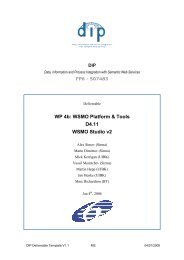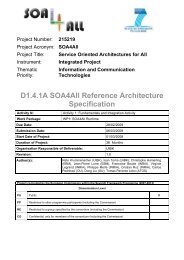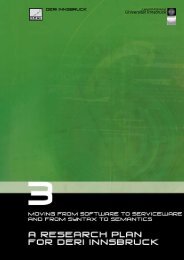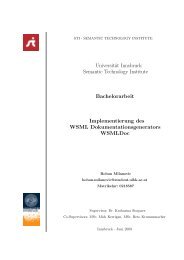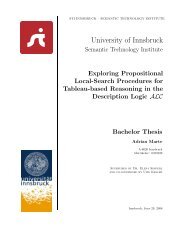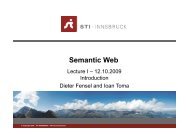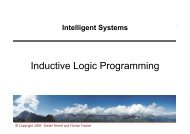Exercise sheet 5 Search Methods - STI Innsbruck
Exercise sheet 5 Search Methods - STI Innsbruck
Exercise sheet 5 Search Methods - STI Innsbruck
Create successful ePaper yourself
Turn your PDF publications into a flip-book with our unique Google optimized e-Paper software.
Intelligent Systems<br />
<strong>Exercise</strong> <strong>sheet</strong> 5<br />
<strong>Search</strong> <strong>Methods</strong><br />
This exercise <strong>sheet</strong> is about search methods. The exercise consists of two parts, first you will have to<br />
model the environment in a way that is recognizable by a computer agent. Second, you will have to<br />
implement a search algorithm in a generic way and thereafter apply it to the problem 1 .<br />
B<br />
A<br />
Assume a plane with convex obstacles similar as shown in the picture above. For any two points (A)<br />
and (B) find the shortest path between them; this is an idealization of the problem that a robot has<br />
to navigate through an environment.<br />
<strong>Exercise</strong> 1 (10 points)<br />
Suppose the state space of the agents consists of all positions (x,y) in the plane. How many states are<br />
there? How many paths are there to the goal?<br />
Explain briefly why the shortest path from one polygon vertex to any other in the scene must consist<br />
of straight-line segments joining some of the vertices of the polygons. Define a good space state<br />
now. How large is the state space?<br />
Define the necessary functions to implement the search problem, including a successor function that<br />
takes a vertex as input and returns a set of vertices that can be reached in a straight line from the<br />
given vertex. 2 Use the straight line distance for the heuristic function.<br />
Now that you abstracted the problem to a successor and heuristic function, implement it in your<br />
favorite programming language. Implement an example plane that is of similar complexity as the one<br />
shown in the figure above. Note that your successor function can be implemented statically, i.e. your<br />
1 <strong>Exercise</strong> adapted from Artificial Intelligence: A Modern Approach, Stuart Russell and Peter Norvig, Prentice<br />
Hall, 1995<br />
2 Do not forget the neighbors on the same polygon
implementation does not need to compute it for some environment, but can look it up in a table that<br />
you filled in advance.<br />
<strong>Exercise</strong> 2 (10 points)<br />
Implement the A* algorithm as defined on the lecture slides, keep the implementation independent 3<br />
of the problem given in <strong>Exercise</strong> 1. If done so, apply it to solve the problem of <strong>Exercise</strong> 1.<br />
3 i.e. you should be able to reuse it for any other admissible problem




